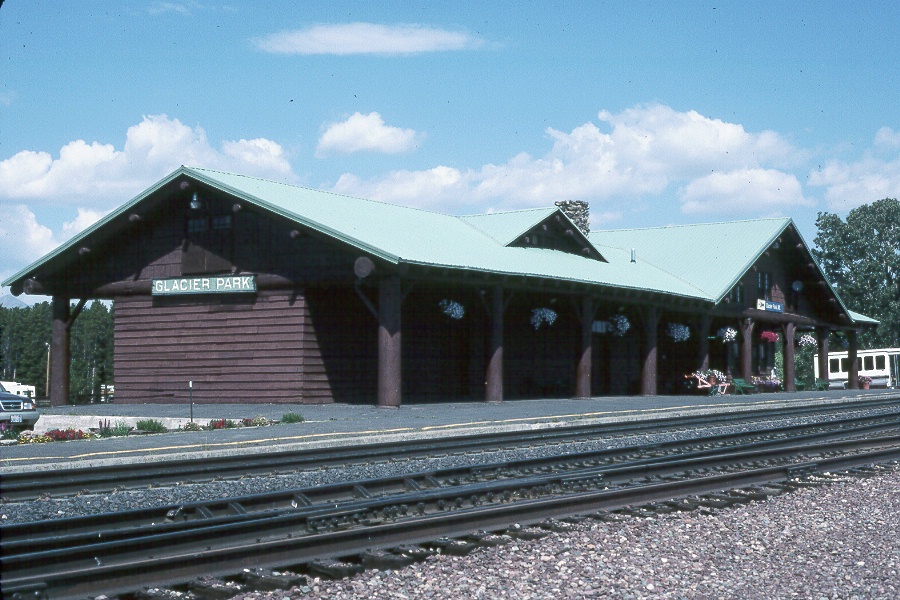The
“Empire Builder”, James Jerome Hill forged his Great Northern railway
across the northern prairies and the mountains of the Pacific Northwest.
Completed in 1893 to Seattle, the Great Northern linked St. Paul, Minnesota to
the developing Northwest. Northern Pacific was already there when the Great
Northern pushed its own line west and the two railroads would be competitors
for many years.
James
J. Hill was born of Scottish-Canadian ancestry in humble beginnings. An
accident early in his life has left him blinded in one eye. In spite of this,
Hill developed a keen business sense, and established himself in St. Paul in
the then booming steamboat era. Soon however, railroads caught the young
man’s attention, and Hill was in the right place at the right time to
capitalize on the financial panic of 1873. The little St. Paul & Pacific
Railroad went into receivership, and Hill saw his opportunity. Sinking his
life savings into the line, he soon was extending it to a connection to the
Canadian border to Winnipeg. Hill developed as he built, exploiting lumber in
Minnesota and wheat in the Red River valley. The Dakotas were wide open in
those years, and Hill foresaw the huge wheat farming potential of the plains.
The high plains and mountains of Montana were soon crossed by Hill’s
railroad as its transcontinental line pushed toward Puget Sound. In the
northwest, the seemingly endless timber reserves were exploited. Montana
yielded timber, coal, copper and other mineral resources. Ever watchful of his
railroad and the bottom line, Hill inspected everything with the economical
eye of a Scot. A story is told that he had discovered a brand new track spike
lying loose on the roadbed. Hill, in a huff, set off to find the wasteful
track section foreman. The foreman however, must have been a quick thinker.
When he saw Hill approaching, he hurried toward him and exclaimed “Thank
goodness you found that spike, Mr. Hill. I’ve had three men looking for it
for nearly a week.”
In
1901, Theodore Roosevelt assumed the Presidency after the assassination of
William McKinley. Roosevelt had set the precedent in establishing many of the
great national parks. He wisely set aside many of the national forests we
enjoy today. It would take three attempts in Congress before Glacier National
Park would finally be created. At the urging of the Great Northern’s Louis
Warren Hill, one of J.J.’s three sons, and successor as president of the
railroad, a bill authorizing the national park passed in 1910 and was signed
by President William Howard Taft. Called the “crown of the continent”,
Glacier National Park was a spectacular array of snow capped peaks, deep
glacial lakes and virgin forests. The Great Northern Railway heavily promoted
passenger service to the park, and commissioned construction of nine chalet
hotel complexes as well as the showpiece Glacier Park Hotel in East Glacier.
The station is known as Glacier Park on the railroad.
The
rustic log construction of the Glacier Park station complements that of the
Glacier Hotel located a short distance away. The station accommodated the
thousands of summer visitors to the park who began their exploration of its
scenic splendors when they stepped off one of Great Northern’s Pullmans. The
railroad heavily promoted the park and the many hotels throughout the
1920’s. Leisure travel to Glacier Park reached all time highs in 1929, and
the railroad introduced a new first class train, the Empire Builder, in honor
of J.J. Hill. During the ensuing Great Depression, passenger traffic to the
park plummeted, and the railroad closed several of the chalets. During World
War II, Glacier Park Hotel itself was not opened for the 1943 season. Even
before the War, automobile traffic had started to erode the passenger
business, but the Great Northern Railway still was a busy place. The station
was a beehive of activity twice a day when the Oriental Limited arrived. This
train later became the Empire Builder. In the late 1940’s and early 1950’s
the railway introduced a new Empire Builder streamliner. Advertisements
extolled the scenery, the “smoothest roadbed in the Northwest” and the
train’s new diesel powered consists with domes, modern coaches, and new
sleepers. In the dining car, the railroad introduced new china with a western
evergreen motif, “Glory of the West” to complement the train and the
signature Great Northern Rocky Mountain goat.
